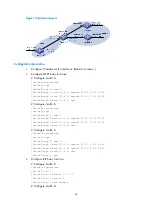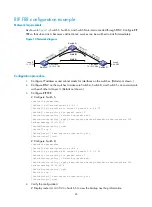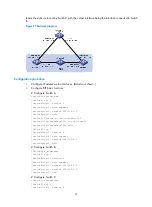
55
•
Each router uses the SPF algorithm to compute a shortest path tree showing the routes to the nodes
in the AS. The router itself is the root of the tree.
Router ID
An OSPF process running on a router must have its own router ID. This ID is a 32-bit unsigned integer that
uniquely identifies the router in the AS.
OSPF packets
OSPF uses the following types of packets:
•
Hello
—Periodically sent to find and maintain neighbors, containing the values of some timers,
information about the DR, BDR, and known neighbors.
•
Database description (DD)
—Describes the digest of each LSA in the LSDB, exchanged between two
routers for data synchronization.
•
Link state request (LSR)
—Requests needed LSAs from the neighbor. After exchanging the DD
packets, the two routers know which LSAs of the neighbor are missing from their LSDBs. They then
send an LSR packet to each other, requesting the missing LSAs. The LSA packet contains the digest
of the missing LSAs.
•
Link state update (LSU)
—Transmits the requested LSAs to the neighbor.
•
Link state acknowledgment (LSAck)
—Acknowledges received LSU packets. It contains the headers
of received LSAs (an LSAck packet can acknowledge multiple LSAs).
LSA types
OSPF sends routing information in LSAs, which—as defined in RFC 2328—have the following types:
•
Router LSA
—Type-1 LSA, originated by all routers, flooded throughout a single area only. This LSA
describes the collected states of the router's interfaces to an area.
•
Network LSA
—Type-2 LSA, originated for broadcast and NBMA networks by the designated router,
flooded throughout a single area only. This LSA contains the list of routers connected to the network.
•
Network Summary LSA
—Type-3 LSA, originated by ABRs (Area Border Routers), and flooded
throughout the LSA's associated area. Each summary-LSA describes a route to a destination outside
the area, yet still inside the AS (an inter-area route).
•
ASBR Summary LSA
—Type-4 LSA, originated by ABRs and flooded throughout the LSA's
associated area. Type 4 summary-LSAs describe routes to ASBR (Autonomous System Boundary
Router).
•
AS External LSA
—Type-5 LSA, originated by ASBRs, and flooded throughout the AS (except stub
and NSSA areas). Each AS-external-LSA describes a route to another AS.
•
NSSA LSA
—Type-7 LSA, as defined in RFC 1587, originated by ASBRs in NSSAs (Not-So-Stubby
Areas) and flooded throughout a single NSSA. NSSA LSAs describe routes to other ASs.
•
Opaque LSA
—A proposed type of LSA, the format consisting of a standard LSA header and
application specific information. Opaque LSAs are used by the OSPF protocol or by some
application to distribute information into the OSPF routing domain. The opaque LSA includes Type
9, Type 10, and Type 11. The Type 9 opaque LSA is flooded into the local subnet, the Type 10 is
flooded into the local area, and the Type 11 is flooded throughout the AS.
Neighbor and Adjacency
In OSPF, "neighbor" and "adjacency" are different concepts.
















































